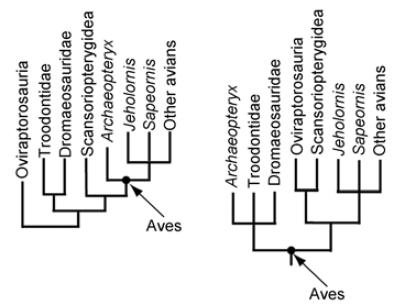Tracking the Emergence of Birds
/https://tf-cmsv2-smithsonianmag-media.s3.amazonaws.com/filer/20110520083245Jeholornis_mmartyniuk_wiki-300x224.jpg)
Since the description of the fuzzy-feathered dinosaur Sinosauropteryx in 1996, paleontologists have been inundated with a still-flowing flood of fossil evidence confirming that birds are living dinosaurs. More than that, many of the characteristics we once thought were unique to birds—from air-sacs to infestations of peculiar microorganisms—were common among dinosaurs, too, and every year it seems that dinosaurs become just a little more bird-like. This does not mean that we now understand everything we need to know about the origin of birds, however. With so many unique fossils changing our understanding at such a rapid rate, the exact details of when the first birds evolved and which lineage of feathered dinosaurs they originated from are still unclear.
Our changing understanding of bird origins is addressed in the Chinese Science Bulletin by paleontologists Xu Xing, Ma Qing Yu and Hu Dong Yu. The key to this evolutionary pattern is Archaeopteryx, a 150-million-year-old feathered dinosaur traditionally regarded as the earliest known bird. This sets the origin of birds in the Late Jurassic, but many of the feathered coelurosaurs—the larger group of theropod dinosaurs which birds are nested in—known so far lived after Archaeopteryx. The earlier, Jurassic dinosaurs that would have been ancestral to both birds and the other feathered dinosaurs have been notoriously difficult to find, but better sampling of Jurassic-age strata have provided more context for the origin of birds and feathered dinosaurs.
In their review, the authors list the recent discovery of many Jurassic and Early Cretaceous coelurosaurs, from the early tyrannosaur Proceratosaurus to the strange, tiny dinosaur Epidexipteryx. Together these specimens help flesh out the pattern of early coelurosaur evolution by allowing scientists to determine which traits are archaic and which are later specializations, and this may shake up the traditional picture of bird origins.
Parsing the evolutionary relationships of birds requires a fair amount of esoteric scientific terms. Even though the deinonychosaurs—a group made up of troodontids such as Saurornithoides and dromaeosaurids such as Velociraptor—have typically been taken as the closest relatives of the first birds, the new paper proposes that they are a bit further removed from bird origins. The breakdown would look something like this. Archaeopteryx, placed in the context of all the feathered dinosaurs we now know of, would group with the deinonychosaurs, whereas all definitive early birds would be more closely related to Epidexipteryx and oviraptorosaurs such as Citipati and Incisivosaurus. (See the evolutionary tree on the right above.)
This new arrangement has yet to be fully tested and analyzed—it is a provisional hypothesis which will rest on further discoveries—but if correct it raises the sticky question of what we call a bird. If we keep Archaeopteryx as a bird in this arrangement, then all the deinonychosaurs, the oviraptorosaurs, and Epidexipteryx would be birds, too. Then again, we could strip Archaeopteryx of its long-held title of "earliest known bird" and give that title to Jeholornis, thus keeping the more traditional image of what a bird is. Admittedly, the latter option makes more sense to me than extending the "bird" designation to such a wide group of feathered dinosaurs, but no doubt what is or is not an early bird will be something that paleontologists will be grappling with for some time to come. Frustrating, perhaps, but it is also wonderful that we have so many well-preserved fossils that the distinction between bird and non-avian dinosaur has become so difficult to figure out!
References:
Xu, X., Ma, Q., & Hu, D. (2010). Pre-Archaeopteryx coelurosaurian dinosaurs and their implications for understanding avian origins Chinese Science Bulletin DOI: 10.1007/s11434-010-4150-z
/https://tf-cmsv2-smithsonianmag-media.s3.amazonaws.com/accounts/headshot/RileyBlack.png)

/https://tf-cmsv2-smithsonianmag-media.s3.amazonaws.com/accounts/headshot/RileyBlack.png)